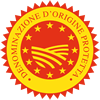Description
Provola dei Nebrodi PDO is a spun paste cheese produced with raw whole cow's milk, in three typologies with a different degree of ripeness – Fresca (Fresh), Semistagionata (Semi-mature), Stagionata (Mature) – and in two unique varieties: Sfoglia (flaky) and with Limone Verde (green lemon).
Production Area
The production area of Provola dei Nebrodi PDO is within the entire administrative territory of numerous municipalities in the provinces of Catania, Enna and Messina, in the Sicily region.
Production Method
Raw whole cow's milk from one or two milkings, obtained from cows fed with at least 60% fodder from the production area, is curdled in a wooden vat at a temperature of about 36 °C, with the addition of kid or lamb rennet paste. The curd is traditionally broken with a “rotula”, a wooden pole with a spoon-like end, which reduces the grains to the size of a grain of rice. After being scalded in hot water, between 65 and 70 °C, the curd is left to rest on a tavuliere (wooden board), covered with a linen or cotton cloth. The curd slices are placed in typical wooden containers called piddiaturi for spinning, and then covered with boiling hot "scotta" (second cheese whey). The slices are melted to obtain a homogeneous, spherical cheese mass, with the help of a wooden stick called a manuvedda. After the cheese has been spun, the cheesemaker creates pear shapes using the ancient manual ‘ncuppatina technique, and seals the provola by dipping it in boiling whey. During the shaping of the Limone Verde variety, the cheesemaker incorporates a whole green lemon into the centre of the pear-shaped cheese. Once shaped, the provola is immersed in cold water and then in brine for a whole day. The cheeses are then ripened: they are hung by the neck in pairs, with a natural fibre rope, over a pole and/or supporting plank.
Appearance and Flavour
Provola dei Nebrodi PDO has a smooth, thin rind without any creases, and a creamy straw colour that becomes golden-yellow with aging. Its size varies according to the weight: the height of the oblong side ranges from 15 to 35 cm, and it has a diameter of 12 to 25 cm. The Fresca variety weighs between 1 and 2 kg and has a classic pear shape, with or without a “head”. The cheese is soft, ivory-white in colour, and has a slightly sweet acidic taste. The Semistagionata, Stagionata, Sfoglia and Limone Verde varieties weigh between 2 to 10 kg, and have an oval shape with a short neck that widens at the top, with or without a “head”. As the cheese ripens, the flavour becomes increasingly more piquant, and the colour varies from yellow to amber. The cheese can be semi-hard to hard, and it can become flaky the more it ripens. The variety with the green lemon maintains a softer texture, although still semi-hard, due to the slow release of moisture from the lemon incorporated in the cheese.
History
Provola dei Nebrodi PDO is one of the oldest cheeses in Sicily. The traditional production systems for this historic spun paste cheese were explained in the writings of the priest Gaetano Solomone at the end of the 19th century.
Gastronomy
Provola dei Nebrodi PDO is best kept in a cool environment, or in the least cold compartment of the refrigerator at a temperature of 4 °C. It is an excellent table cheese and the maturer varieties are ideal for grating. Traditionally it is cooked “all’argentiera”, that is, sautéed in a pan with garlic, anchovies and a little vinegar.
Marketing
The product is marketed as Provola dei Nebrodi PDO in the following typologies: Fresca, Semistagionata, Stagionata, Sfoglia and with Limone Verde. All the whole cheeses, regardless of how mature they are, bear the fire-branded logo and the dairy’s identification stamp that contains the following information: type of product, producer’s identification number and the product’s sequential identification number. Provola dei Nebrodi PDO is sold whole, in pieces, or grated.
Distinctive Features
The spontaneous forage species found in the Nebroideo Massif, and the cultivated grasses – honeysuckle, clover, vetch and fodder cereals – which make up the cattle's basic diet, contribute to the formation of the typical aromatic profile of Provola dei Nebrodi PDO.









